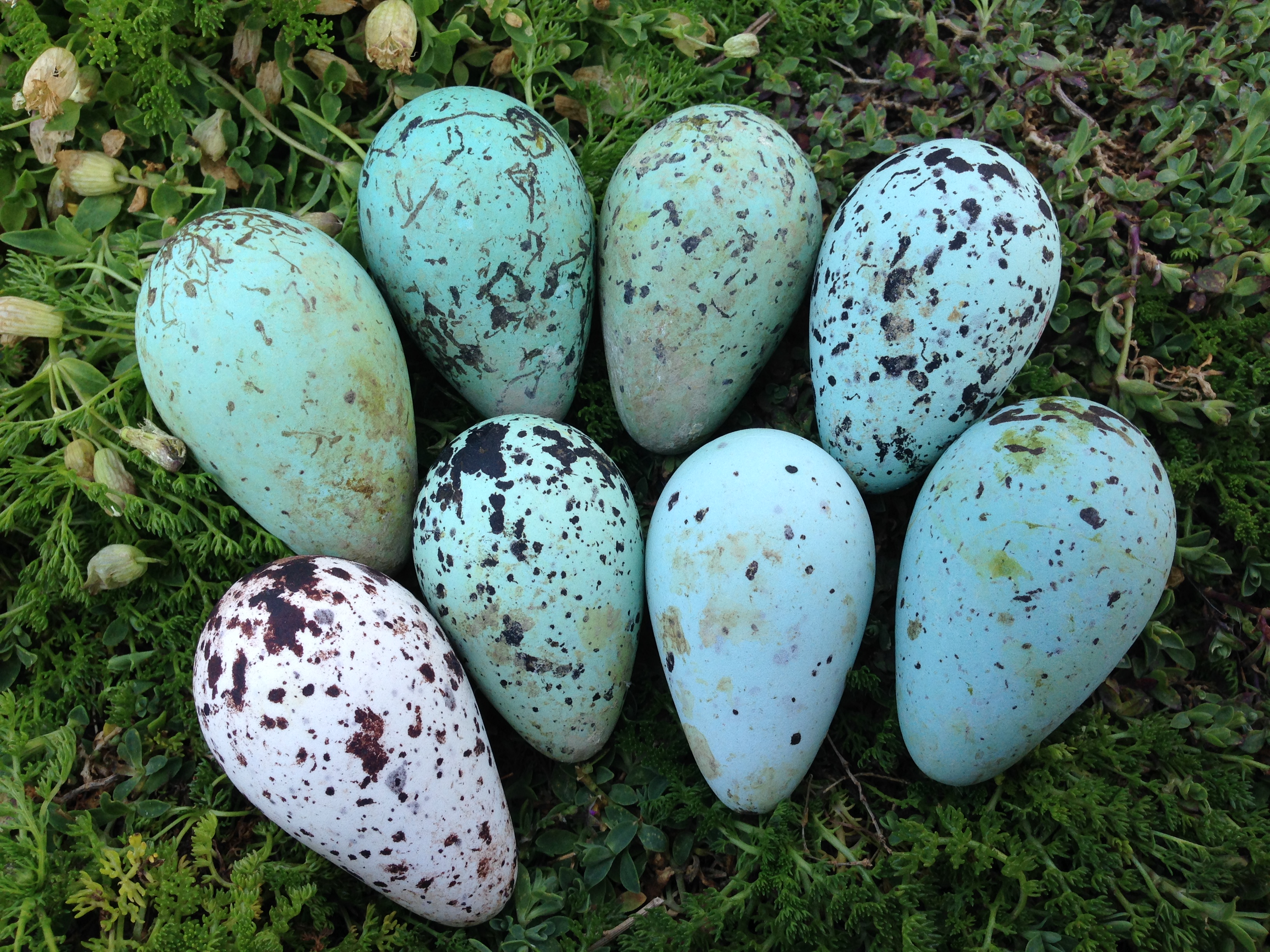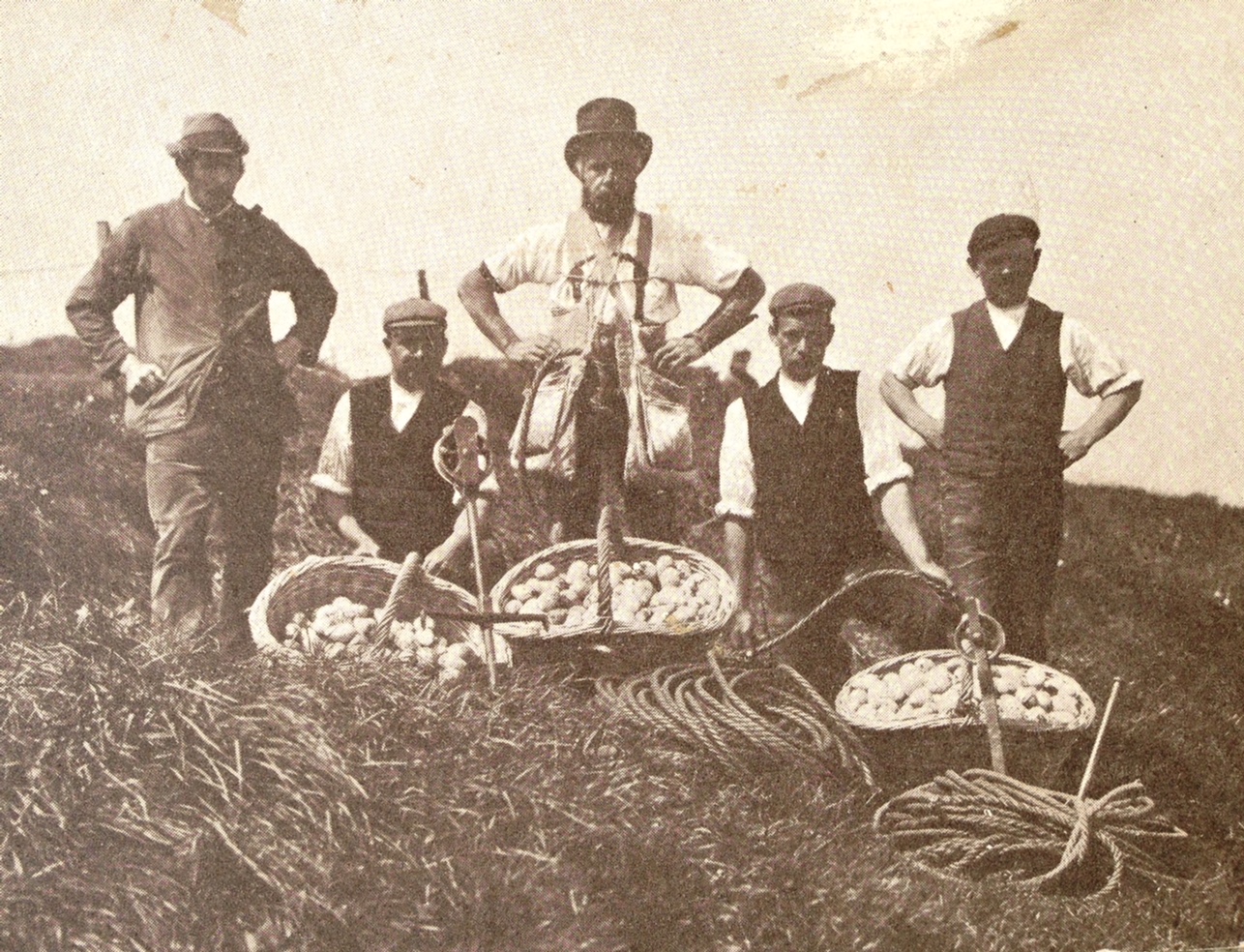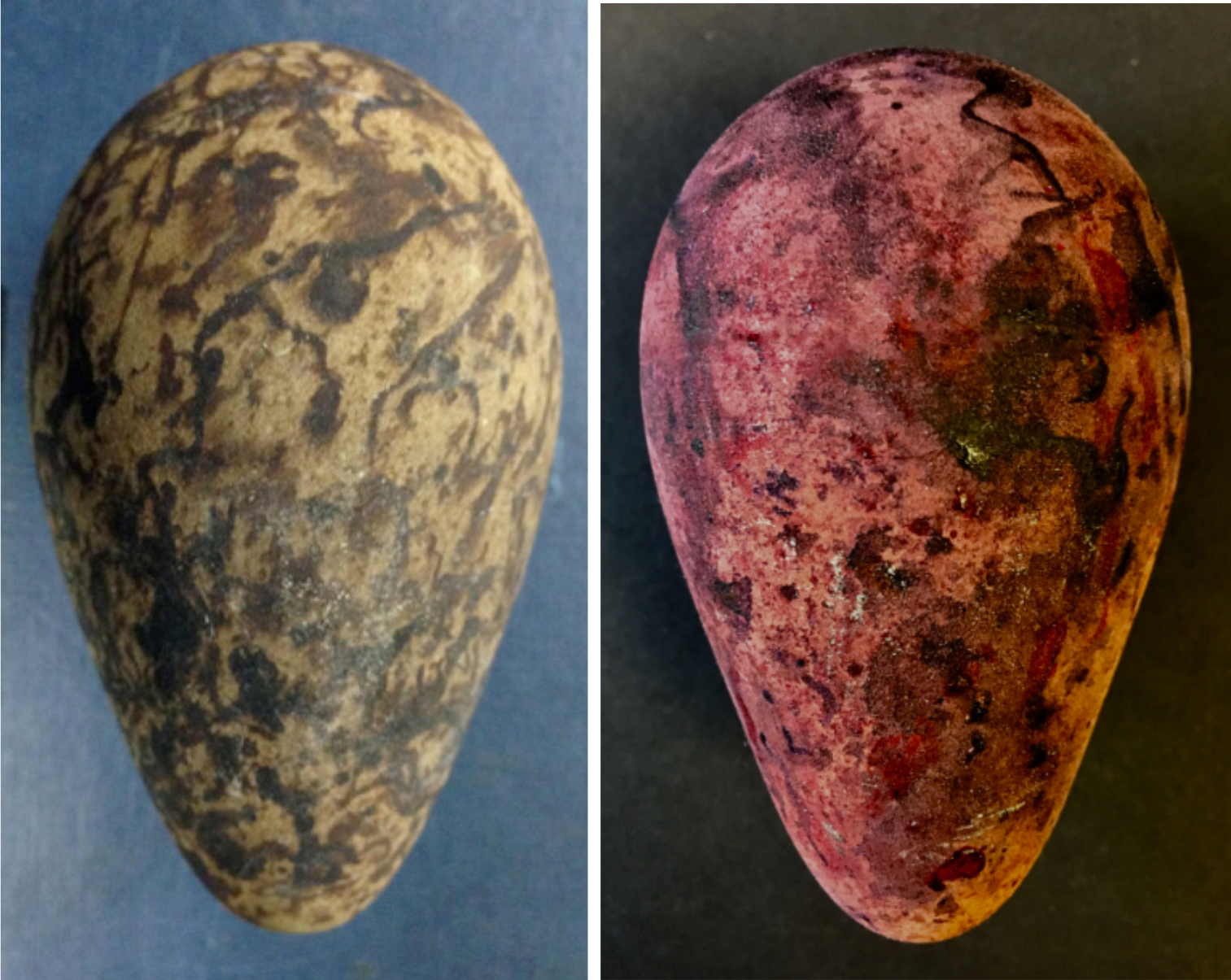
The cover or frontispiece of almost every book about birds’ eggs is adorned with a picture of a common guillemot (Common Murre [1]) egg. Why? There are several reasons—the common guillemot’s egg is an extraordinary shape, it’s brightly coloured, and the variation in the colour and maculation seems almost infinite.
Egg collectors, or oölogists as they called themselves, accumulated collections of eggs mainly for aesthetic reasons, and there are few eggs more aesthetic of those of the guillemot. Collectors also liked to display the range of variation in egg colour. With the exception of one or two species like the tawny-flanked prinia Prinia subflava [2], there is more variation in the colours and patterns of guillemot eggs than any other species.
That variation is apparent if you open a museum draw of guillemot eggs. But it is a fraction of the variation apparent in freshly laid eggs on the ledges where these birds breed. Eggs in museum collections often fade unless protected from the light, and I have seen many an old collection where almost all the eggs have converged to a pale, muddy, bluish-green background colour. The markings, which are always darker, seem not to fade, so much of the variation in guillemot one sees in museums is in those maculations. Oölogists described those maculation as ‘salt and pepper’, ‘black cap’, ‘lose cap’, ‘shorthand’, and ‘scrawl’. Ornithologists have been more pragmatic and less poetic.
The majority of common guillemot eggs have a blue, green or white ground colour over which lie the various forms of maculation. In their competitive quest for eggs, oölogists sought—and sometimes fought over—the rarest types. This was especially true at Bempton Cliffs on the Flamborough Headland on England’s northeastern coast, where egging was an industry in the mid-nineteenth and mid-twentieth century. Tens of thousands of guillemot eggs were collected at Bempton each year, mainly for food, but also for the oölogists’ cabinets. Providing you were a wealthy enough oölogist, these were easy pickings. Farm labourers, known locally as ‘climmers’ (climbers) did all the work and took all the risks, scaling the 400-foot vertical cliffs to get the eggs. The collectors merely patrolled the cliff tops waiting to see what the climmers brought up.

It was a market: the climmers knew what the collectors wanted, and negotiated hard for a decent price. Farm labourers’ salaries were low and selling eggs was an important source of additional income for the climmers. At a time when £3 was a decent weekly wage (for anyone, let alone a farm worker), an unusually coloured egg that sold for £1 was real bonus. The commoner egg shapes and colours went for a few pennies. The rarest guillemot eggs of all were those of a port-wine or blood red colour. The esteem with which such eggs were held was celebrated by the nick-name ‘Bempton Belle’ given to one egg from Bempton. Strictly speaking, the name should have referred to the female that laid this red egg since female guillemots always produce the same type and colour of egg.
When Bob Montgomerie and I visited the fabulous egg collection at the Delaware Museum of Natural History (DMNH) [3] we found the following typewritten poem tucked into the bottom of one of the small egg boxes in a drawer full of guillemot eggs:
THE BEMPTON BELLE
Listen Boys until I tell,
Of the famous egg — the Bempton Belle.
Seventeen days in June had gone;
When Jack the Climber came upon,
And brought from off the cliffs the Red;
The best ever seen by the veteran Ned.
William the Jumper struck with awe;
Said that a better egg he never saw.
Even silent Edwin Colley speaks,
Of the shape, and beautiful streaks.
The Boys all wondered at the shell,
Of the famous Red, the Bempton Belle.
Collectors who came from far and near,
Said they had never seen its peer.
Every man was fair to own,
The Bempton Belle the best egg known.
Jack the Here of the find;
Saved the egg for friendship kind.
Remember Boys the lesson taught;
True friendship can not be bought. [4]
This particular egg was part of Jeremiah Goodall’s egg collection (now in the DMNH) that he accumulated in the early 1900s. We don’t know whether it was Goodall who wrote the poem, but someone has added in pen that ‘Jack’ was Jack Hodgson, ‘Ned’ was Ned Hodgson and ‘William the Jumper’ was William Wilkinson, all climmers.

We have attempted to assess just how rare such eggs were, and after looking at our own data and those of other guillemot researchers, we estimate that fewer than one in 1000, or possibly 10,000 female guillemots produce such extraordinary eggs [6].
SOURCES
- Birkhead TR, Montgomerie R (2018) Rare red eggs of the Common Guillemot: birds, biology and people at Bempton, Yorkshire, in the early 1900s. Archives of Natural History 45: 69-79.
- Boehm EF (1950) Abnormal erythrism in birds’ eggs. Emu 50:139.
- Caves EM, Stevens M, Iversen E, Spottiswoode CN (2015) Hosts of brood parasites have evolved egg signatures with elevated information content. Proceedings of the Royal Society of London B 282: 20150598.
- Gill F, Donsker D, Eds (2018) IOC World Bird List (v8.1). doi: 14344/IOC.ML.8.1. Online at http://www.worldbirdnames.org
- Gross AO (1966) Erythristic eggs. The Wilson Bulletin 78: 127–128.
- Rarer ECS (1918) IV.‐Erythrism in bids’ eggs: an address read at the Third Oological Dinner on 26 September, 1917. Ibis 60: 68–75.
Footnotes
- common guillemot: The ‘official’ name of this species (Uria aalge) is Common Murre according to Gill and Donsker (2018) and HBW Alive/Bird Life International. Common guillemot is the name still used for this species in the UK.
- prinia egg colours: see Cave et al. (2015)
- Delaware Museum of Natural History: just north of Wilmington, this museum was established
- poem: See Birkhead and Montgomerie (2018) for a picture of the original. On that typescript someone has added some details in pen, and changed the last line and added two more: Honest Jack could not be bought/To your children the story tell/Of Jack the Climber, & the Bempton Belle.
- Bempton Belle photo: the actual egg now in the collection at DMNH; I painted the replica to show what the original probably have looked like, based on red guillemot eggs currently in the collection of the Natural History Museum at Tring (see Birkhead and Montgomerie 2018, Figure 1)
- rarity of erythristic guillemot eggs: see Birkhead and Montgomerie (2018) on the Bempton Belle and erythrism in murre eggs. See also Boehm (1950), Gross (1966), and Rarer (1918) on erythrism in birds’ eggs in general. Erythrism is either the result of addition protoporphyrin IX being added to the shell by the female, of biliverdin not being added to a shell that normally would have both pigments.
IMAGES: Bempton ‘climmers from an old postcard; Bempton Belle poem and photo © Delaware Museum of Natural History, used with permission of Dr Jean Woods, Curator of Birds; photo of guillemot eggs on Skomer and replica red egg © T R Birkhead.
COMMENTS